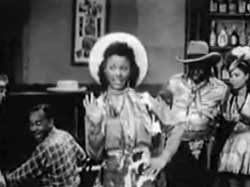 Dorothy Dandridge stars in Cow-Cow Boogie (1942), a particularly fine two & a half minute panoram soundie.
Dorothy Dandridge stars in Cow-Cow Boogie (1942), a particularly fine two & a half minute panoram soundie.
An elaborate set establishes this as a black jazz club, romantically seedy with bar, piano player, guys sitting around at tables, scanty-clad damsels smoking & standing about.
This isn't a Harlem club, however. It has the look of the wild, wild west. And why not? After the Civil War & manumition, there were more black cowboys than white ones in many a town, & they often had their own saloons.
Out comes Dorothy Dandridge clad as a cowgirl in a pinto-pony print miniskirt & cowboy hat. She sings, absolutely wonderfully, the title song Cow-Cow Boogie, western swing at its best, despite that she was known for other things.
Comedian Dudley Dickerson puts in an appearance as a yippying cowboy who fires off his pistol just before the harmonica solo, to which Dandridge shows her dance-steps, with the rest of the women in the saloon lining up behind her.
What a delightful soundie! Dorothy also added massive charm guest-starring in the Mills Brothers soundie Paper Doll (1942). There are more reviews of Dandridge soundies & clips with on the same page with my review of the documentary Dorothy Dandridge: An American Beauty (2003).
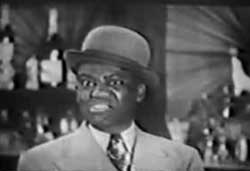 Bill "Bojangles" Robinson stars in the Panoram visual jukebox soundie Let's Scuffle (1942). It should doubtless be regarded a "dancie" instead of a soundie.
Bill "Bojangles" Robinson stars in the Panoram visual jukebox soundie Let's Scuffle (1942). It should doubtless be regarded a "dancie" instead of a soundie.
The stage is minimally arranged to look like a cocktail lounge. Bojangles in his trademark bowler hat sits at the counter with a lovely lady seated beside him.
He starts off singing a little diddy: "Everyone is crazy 'bout this dance/ You've got to learn it or you don't stand a chance/ It's called the scuffle, that's all you say/ You grab your gal & start to swing & sway."
When he finishes the lyrics he doesn' grab one of the gals to swing & sway but bursts into tapdance while several gals & guys watch from their cafe tables.
Through part of the dance he's shown from the waist up so the cinematographer wasn't thinking the best. It's a nice old-fashioned performance overall & Bojangle as always possesses enormous charm.
This short-short was also included on the one-reel collection of three soundies Sepian Stars on Parade (1947) together with Bob Howard's She's Too Hot to Handle (1944) & the Mills Brothers' Till Then (1944).
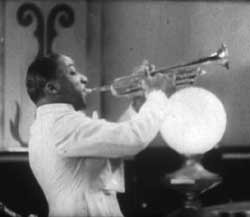 Erskine Hawkins & His Jiving Sepia Scorchers really are a scorching little orchestra. Erskine Hawkins & His Jiving Sepia Scorchers really are a scorching little orchestra.
Erskine in white tuxedo akin to that of Cab Calloway conducts his band with trumpet in hand. Sax, trumbones, slap-bass & hat-muted horns give out a sound worth of the title Hot in the Groove (1942).
There's a sax solo prelude to Erskine's own stocato trumpet solo. It's an unusually short instrumental soundie that never lets up the energy until it comes to an abrupt close.
This is Erskine's only soundie, though another of his compositions, the WWII big-band standard Tuxedo Junction (1942), was filmed with Edna Mae Harris performing.
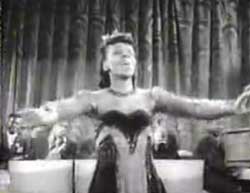 Stepping Along (1943) opens with two young dancers in tophats tapdancing. They're part of The Sepia Steppers, an all-black troupe of singers & dancers. These two fellows are smiling ear to ear & cute as buttons, one short, one tall.
Stepping Along (1943) opens with two young dancers in tophats tapdancing. They're part of The Sepia Steppers, an all-black troupe of singers & dancers. These two fellows are smiling ear to ear & cute as buttons, one short, one tall.
Then out come some choras girls who are also Sepia Steppers. It seriously looks like two young lads dancing away while the grown gals in short skirts take over the stage. However, those two tapdancing guys aren't nearly as young as they look, though more on that anon.
The four chorus girls shake their booties & do some quick, simple routines. Then Evelyn Keyes steps center stage & begins to sing: "Don't forget your white tie/ New top hat & oh my/ Mustn't be late for we've a date / Let's be steppin' along."
This is a wonderful soundie reminiscent of the all-black-cast jazz films of the 1930s & 40s, but in miniature.
When Evelyn burst into dance it was like the cherry on top of the sundae, though why one of the less talented dancers finishes off at the end has got to have something to do with the producer getting laid.
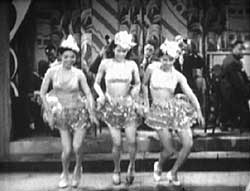 The Sepia Steppers return in the soundie Chatter (1943). It begins with three chorus girls dancing their sweet hearts out, on the same set as for Stepping ALong, decked out to look like a really nice small dinner club in Harlem.
The Sepia Steppers return in the soundie Chatter (1943). It begins with three chorus girls dancing their sweet hearts out, on the same set as for Stepping ALong, decked out to look like a really nice small dinner club in Harlem.
The same quintet as seen in Stepping Along is again glimpsed in the background; beyond being another element of the Sepia Steppers troupe, this small band is unidentified.
A screen-capture of the piano-man is included with this review; I'd be so grateful if someone recognized him & e-mailed me who he is
The gals dance off stage & in come those two tapdancing lads, short one & tall one, reminiscent of the Nicholas Brothers though not that good though awfully good. They're cute as buttons tapdancing up a storm, spats on their shoes.
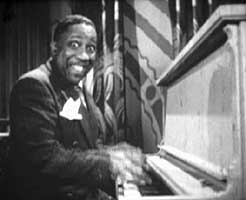 However, the jingly piano's rag-timey version of "I've Got Rhythm" is all one hears, without a single tapping sound making it onto the recording. However, the jingly piano's rag-timey version of "I've Got Rhythm" is all one hears, without a single tapping sound making it onto the recording.
The dance duo providing the central act among the Sepia Stepers are Charles "Cookie" Cook & Ernest "Brownie" Brown.
Although they're such slim small guys with young faces that they look like kids, in fact they got their start with Ben Bernie's Orchestra in 1930.
Throughout the 1930s, as "Cook & Brown," they were a top-billed vaudeville team, & danced at the Savoy, Cotton Club, Roxy, London Palladium, & in Europe danced for the Duke Elllington & Count Basie orchestras.
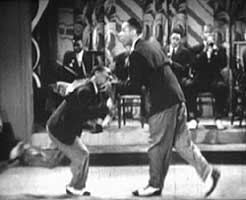 In the 1960s they toured Africa as part of a cultural exchange arranged by the American State Department, & gave a command performance for Ethiopian Emperor Haile Selassie. In the 1960s they toured Africa as part of a cultural exchange arranged by the American State Department, & gave a command performance for Ethiopian Emperor Haile Selassie.
The Cotton Club initially billed the Sepia Steppers as "the Twelve Sepia Ateppers" but their exact number was often shifting.
The troupe, inclusive of Cook & Brown, can be glimpsed in the Robert Montgomery & Tallulah Bankhead film Faithless (1932), during the big show sequences headed up by Cab Calloway together with an array of Cotton Club feature performers.
In 1949 the troupe expanded to become "The Copasetics" of Harlem with twenty-one members, dancers & musicians, & continued to perform into the 1980s with changing membership, though Cook & Brown were on board for just about the entire history of the troupe, & were signal in the tap revival of the 1980s.
So in little soundies like Stepping Along & Chatter, we're seeing more than joyful moments of entertainment; we're glimpsing bits of Harlem history.
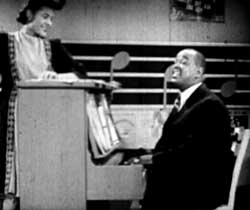 Bob Howard was more or less a Fats Waller impersonator, a hefty fellow who roles his eyes upward & pounds his piano. It's all too obvious the imitation was intentional & even the girl leaning on his piano is Fats shtick.
Bob Howard was more or less a Fats Waller impersonator, a hefty fellow who roles his eyes upward & pounds his piano. It's all too obvious the imitation was intentional & even the girl leaning on his piano is Fats shtick.
He'd had a brief heyday in the mid 1930s when Decca signed him purely because they wanted someone to compete head-on with Fats' releases over at Victor Records. But his contract ended in 1938 & no one else wanted a copy-cat.
He continued performing, however, & William Forest Crouch tracked him down in 1944 to make four soundies in one day, such as would stand forever as his only recordings of the decade.
At the instrumental break for Dinah (1944), the gal at the piano starts dancing & we get a cut-away at one point to see that the stage set is arranged to convey a sheet music company.
There's a trumpet solo from the unseen accompanyist. Bob mugs & scats & gets louder as he goes along, & it's good fun, though inescapably he's not as good as Fats & the fact that he comes off as the imitator certainly accounts for the limitations on his success.
This was included in the Castle Films one-reel anthology of three soundies sold for the home projection market as Songs of Yesteryear (1945).
The other inclusions were a bit of a mismatch: How Come You Do Me Like You Do (1945) featured by Will Bradley's band with Roberta Hollywood singing, with big shadow-silhouettes of musicians on the back wall; & The Bowery (1942) featuring Earl Covert on vocals, backed by pianists Phil Ohman & Norman Burlingame.
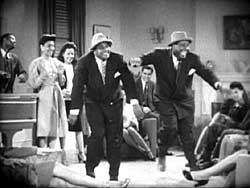 The song, dance & comedy team of Patterson & Jackson -- Al Jackson & Warren Patterson -- appeared in the classic black-cast films Boy, what a Girl (1946) & Killer Diller (1948) as well as in three soundies, including Mama, I Wanna Make Rhythm (1943).
The song, dance & comedy team of Patterson & Jackson -- Al Jackson & Warren Patterson -- appeared in the classic black-cast films Boy, what a Girl (1946) & Killer Diller (1948) as well as in three soundies, including Mama, I Wanna Make Rhythm (1943).
In an intimate living room setting surrounded by friends, our two guys in funny hats are tapdancing up a storm; although, as was often the case in the soundies, no one bothered to record the sound of tapping. After singing some lyrics there'll be more tapping, & this time some of it got recorded.
Soundies, however, were lipsynched from recordings generally made earlier the same day or the day before, & it was never easy to match tap movements, which is doubtless why the directors so often skipped providing a microphone for tap routines.
Patterson & Jackson are chubby guys & look like comedians. But they had great voices & do the jump-jazz number full justice, with some comic scatting tossed in. And for such hefty fellows, they've got energy to spare.
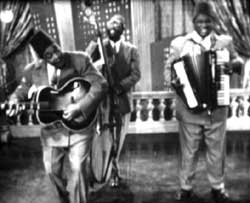 The Ali Baba Trio appear appeared in four soundies, including a cover of Your Feets Too Big (1946). They're on a nicely arrayed stage with impressionist cityscape backdrop. Here they wear fezzes to suit their trio's name, though sometimes they wore turbans.
The Ali Baba Trio appear appeared in four soundies, including a cover of Your Feets Too Big (1946). They're on a nicely arrayed stage with impressionist cityscape backdrop. Here they wear fezzes to suit their trio's name, though sometimes they wore turbans.
They play slap bass, guitar, & accordion. Although they look like comedians, they sing the number totally straight -- as though it weren't inherently just about the goofiest song Fats Waller ever wrote. The accordianist is the best of the three vocalists but none of 'em are great:
"Up in Harlem we had a table for two/ There was three of us, me & your big feet & you/ From your ankles up you look mighty neat/ But from the ankles down you had too much feet."
They're undeniably cute to watch, though not as talented as most of the black artists, well known or obscure, who found their way onto soundies. Everyone gets an instrumental solo, & the bass & guitar ain't too bad, but the accordion dominates & it's nothing special.
copyright © by Paghat the Ratgirl
|
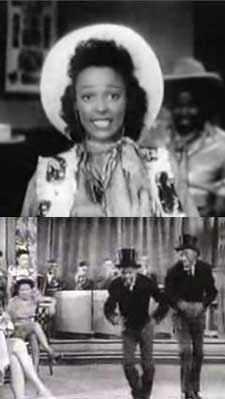





 However, the jingly piano's rag-timey version of "I've Got Rhythm" is all one hears, without a single tapping sound making it onto the recording.
However, the jingly piano's rag-timey version of "I've Got Rhythm" is all one hears, without a single tapping sound making it onto the recording. In the 1960s they toured Africa as part of a cultural exchange arranged by the American State Department, & gave a command performance for Ethiopian Emperor Haile Selassie.
In the 1960s they toured Africa as part of a cultural exchange arranged by the American State Department, & gave a command performance for Ethiopian Emperor Haile Selassie.

